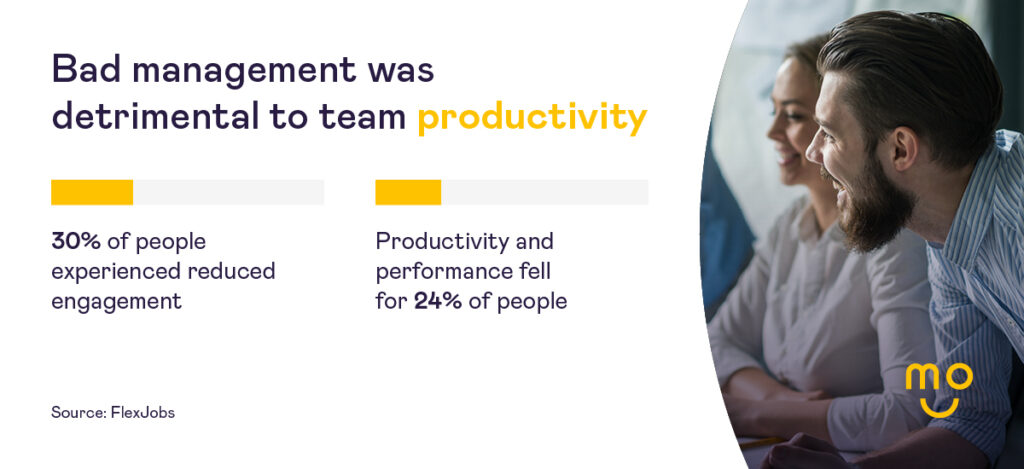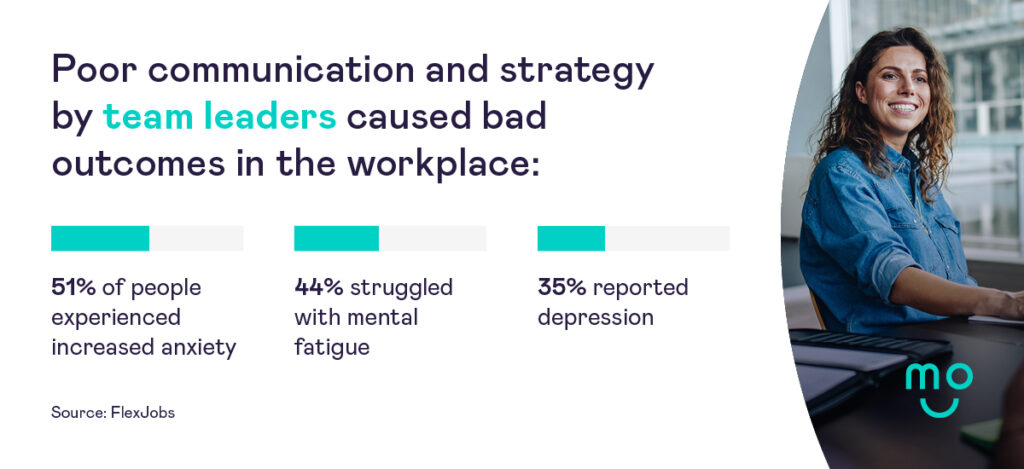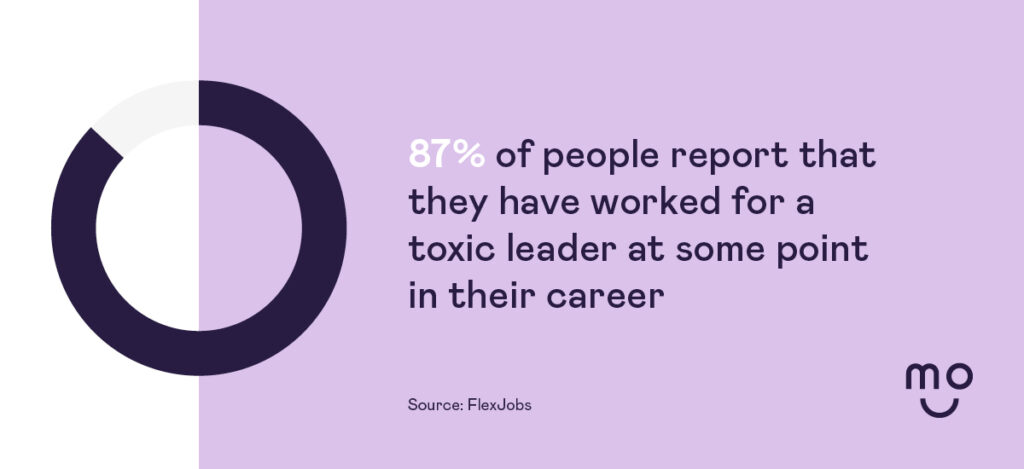Here’s a hard truth: one bad manager can be enough to disrupt positive company culture. The data indicates that 82% of managers end up in the position “accidentally”, while one in four employees have left a job because of a negative relationship with their manager.
While not everyone is as bad as Don Draper, management styles have not advanced at the same pace as modern work practices. Market analysts are connecting a lack of managerial training with poor employee retention, forcing leaders to finally wake up to bad management in their organisations.
Does Anyone Want to Be a Manager?
During a recent HR conference on employee engagement, a member of the audience asked a provocative question. “Does anyone actually want to be a manager?” While some people laughed, others looked uncomfortable. The speaker brushed off the question. “Of course! Why else would they apply for the job?“
There are many other reasons why someone might apply for a managerial role. Employees are often promoted to management positions due to a lack of other advancement opportunities – especially for women or flexible workers. As reluctant managers struggle with inadequate resources, companies in turn blame remote working for a lack of engagement. Managers then come to resent hybrid and remote working for being “difficult to manage”, despite evidence of bias. Sound familiar?
Bad Management is Avoidable
Even well-intentioned bosses aren’t immune to poor management practices. Without proper training, modern challenges – such as hybrid working and generational differences – will impact morale and productivity.
There’s a silver lining: managers are more productive when they feel empowered. In this article, we explain the data and share positive practices that help foster a high-performance culture in any company. If you’d like more help, book a demo call with one of our experts.

Signs of Bad Management Practices
Poor management will negatively affect employees’ day-to-day performance, impacting your business metrics. It has also been proven to impact retention rates. The Guardian recently reported that bad management has prompted one in three UK workers to quit a position, a statistic that will give HR departments sleepless nights.
Based on a report from the Chartered Management Institute (CMI), the article also found that an ineffective manager sapped motivation for a third of those surveyed. Almost half of them considered looking for a new role within the next year.
A Toxic Culture
The pandemic brought with it an awarenes of how mental health is impacted by working conditions. According to a poll by FlexJobs, poor communication and strategy from team leaders caused 51% of employees to experience increased anxiety, while 44% struggled with mental fatigue and 35% reported depression.
The same poll revealed that a bad manager reduced engagement for 30% of people and was responsible for declining productivity and performance for 24%. If we assume that these statistics are connected, they demonstrate the link between employee anxiety and bad performance.
87% of people reporting that they have worked for a toxic leader at some point in their career. If the majority of employees are experiencing bad management practices, it suggests that the problem is endemic and can only be solved by systematic changes.
Proximity Bias
Put simply, proximity bias occurs when in-person employees are given preference over remote or hybrid employees. This can be due to a number of factors:
- In-person relationships are easier to maintain
- More bonding opportunities
- Systemic bias against remote work
- Perpetuates the “boys club” mentality (women are more likely to embrace flexible work)
Bad managers often blame remote work for their failings. Proximity bias proves that there are larger factors at play. Remote workers recieve less feedback than in-person peers. Rather than penalising remote workers, managers must be empowered to engage with their team through solutions like in-person meetings and employee recognition software.

How to Fix Bad Management: 5 Steps to Success
We are all familiar with the adage “people leave managers, not jobs”. How can we improve managment to ensure better outcomes? Here are some of the most common management mistakes – and what to do instead:
1. Break Down Communication Silos
Remote work should not be an excuse to silo communication. This includes opportunities for cross-departmental working and offering employees a sufficient amount of feedback. Knowing how to talk to your employees, peers and leaders is an essential management skill – one that many still struggle with. Recent changes in work patterns, such as hybrid flexibility, have contributed to a breakdown in feedback loops.
Study: “The Bias Against Hybrid Work”
In a recent study, Nick Bloom highlighted the differences between the employee and manager experience of hybrid work. He cited his paper with the National Bureau of Economic Research that looked at quit rates in these two groups – and the results are fascinating.
Hybrid work greatly improved employee experience. Attrition rates fell by 1/3 based on better job satisfaction and improved work-life balance.
On the other hand, manager attrition rose by 55%. Put simply, managers did not like managing people remotely. But is this the whole story?
Before starting their hybrid trials, managers were more likely to predict a negative average impact of hybrid on productivity. Managers expected hybrid work to fail.
There is more research to be done. However, our analysis of problems faced by the managers of remote teams includes:
- Lack of team connection
- Less opportunity to give feedback
- Harder to monitor progress
- Loss of engagement
So what does this mean in practice?
Now that experience is as important to employees as salary, hybrid work is here to stay. But if it is going to be effective in the long term, senior leaders must equip their managers with the right tools to work across hybrid and remote teams.
We have seen engagement and recognition scores increase when our customers introduce our recognition platform as an initiative. Our software improves connection across teams while minimising admin for busy managers. Mo is a recognition assistant – always there to prompt when other things are stealing attention.
Managers fail to appreciate the value of clear and concise communication that flows both ways. It can also be down to a lack of skill, where managers are not aware of the main communication styles at work and the methods of harnessing them. The right tools can make a job much easier.
2. Work Towards Diversity and Inclusion
Fostering a diverse and inclusive workspace will make your team more dynamic. The positive impact is undeniable, improving performance by up to 30% according to data from Gartner.
Ensuring that you have a wide range of skills and experiences within your teams gives them the best possible chance of dealing with challenges. It also allows for a wider perspective and space for innovative thinking.
Sadly, not all industries have recognised the power of investing in diverse workplaces. Managers often bring their personal biases into the workplace; without proper DEI training, these prejudices can fester. Long gone are the days when an employee will remain silent on issues of discrimination, so we enourage you to take proactive steps to train your leaders.
If your managers prioritise diversity and inclusion, they will contribute to a positive company culture which, in turn, reduces attrition rates and boosts productivity.
3. Use the Carrot, Not the Stick
While it’s important to know how and when to step in and offer guidance, an overly harsh and punitive atmosphere is a surefire recipe for disaster. As a general rule, teams work better when they know they’re safe to make mistakes.
Some people do respond well to a management style that focuses on accountability. That’s not the same thing as coming down on someone like a ton of bricks when something goes wrong.
Learning how to have difficult conversations is a key skill for any manager and a constructive approach is nearly always more productive than a punitive one.
Transform your culture with Mo

- Improve employee engagement scores
- Reduce employee churn
- Build a collaborative culture
4. Recognise Invisible Work
With increasing numbers of businesses competing on experience over salary, your company culture matters more than ever. In a bad company culture, the thing most neglected factor is employee recognition. Specifically: recognising invisible work.
After years of research into employee engagement, I noticed that lack of recognition affects every aspect of organisational culture: hiring, productivity and retention. It begs the question: why do companies consistently fail to recognise their staff?
Even Forbes struggled to answer this question. In their article on the importance of regular recognition between managers and employees, Victor Lipman noted that “only 20% of employees feel strongly valued at work. 80% felt poorly to moderately valued.” Without affirmation, employees are prone to disengage – leading to lower productivity and higher turnover.
Recognition is inexpensive to implement but costly to ignore.
5. Prioritise Social Connection
For data on the lack of social connection at work, look no further than Microsoft’s annual Work Trend Index. Their software analyses trillions of productivity signals — including emails, meetings, chats, and posts — across Microsoft and LinkedIn user bases. It also includes an employee survey of more than 30,000 people in 31 countries around the world.
After analysing the data, we noticed three trends:
- People feel disconnected
- Remote work has shrunk networks
- Even close team interactions have diminished
The study also found that younger workers and new starts may be more prone to social isolation. These employees said their relationships with their direct teams were worse and they had a harder time accessing leadership.
Workers aged 18 to 25 reported lower engagement and motivation. They struggled to speak during meetings and bring new ideas to the table.
The research shows that working from home makes people feel less connected, leading to lower participation and motivation. The first step to address this problem? Create a culture of recognition to encourage manager feedback and peer-to-peer recognition.
Mo provides managers and employees with a platform to share their personality, values and achievements. We help people build their work story.

Managing vs Coaching
In a breakthrough article, Gallup has located a “silver bullet” for fixing bad management practices. Based on their data, they propose a coaching-first approach that prioritises weekly coaching sessions above micromanagement.
“Gallup has discovered — through studying what the best managers do differently — that great managing is an act of coaching, not one of directing and administrating.”
The idea is compelling. With 70% of the variance in employee engagement due to management, it’s clear that something is broken.
Incorporating this approach into your recognition strategy is easier than you may think. When you engage Mo’s software, we work with you to shift your management culture towards exemplifying company values and prioritising measurable employee outcomes. We make it easier for managers to meaningfully connect and recognise their employees, which sets the foundation for a feedback-first culture. Book a demo with our experts to start transforming your management strategy.
Fixing Bad Management: Key Takeaways
- Bad management practices can devastate workplace cultures, especially if organisations do not check them.
- Coaching is more effective than micromanagement.
- Training and support can be a smart way to improve those all-important management skills. Likewise, the right tools and software can take some pressure off busy managers and give them more time to get things right.
See how Mo could help your managers be the best they can be. Book a demo or get in touch for a chat.

![[image] 4174782](https://mo.work/wp-content/uploads/2023/12/image-4174782-150x150.jpeg)


